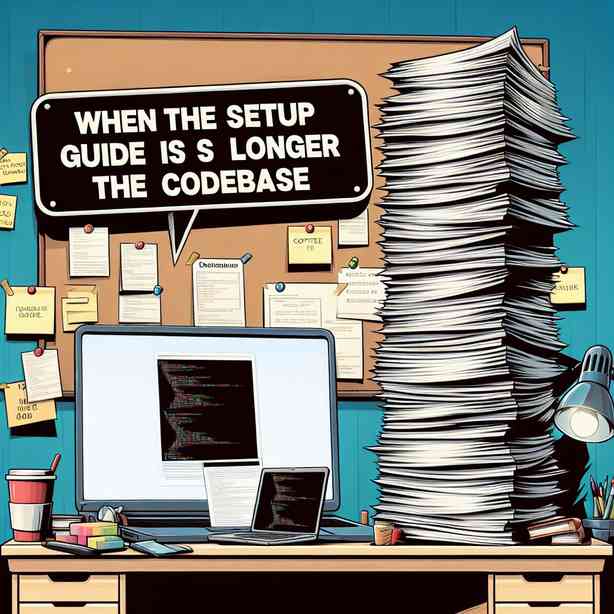
In today’s fast-paced technological landscape, we often find ourselves at a crossroads when it comes to software development. The increasing complexity of systems and the demand for rapid delivery of products can sometimes lead to an ironic situation: what happens when the setup guide for a project is longer than the codebase itself? This phenomenon can feel perplexing to many developers and project managers alike, but it is becoming increasingly common in our ever-evolving industry.
Let’s start by understanding what we mean by a setup guide. A setup guide typically includes detailed instructions, diagrams, and configurations needed to get a software project up and running. It serves as an essential resource for developers and engineers, ensuring that everyone on the team is aligned and has access to the necessary tools and resources. The creation of a comprehensive setup guide is no small feat; it requires thorough documentation, a deep understanding of the project’s architecture, and careful consideration of the end-user and developer experience.
Now, juxtaposing this with a codebase, we see that a codebase typically consists of the actual code that runs the application or system. It encompasses all the programming logic, algorithms, and functionalities needed to fulfill the software’s objectives. In many situations, especially in projects that leverage microservices or modular architectures, the codebase can turn out to be deceptively small. However, the underlying complexity of orchestrating these components often necessitates extensive setup documentation.
One may wonder, why is the setup guide growing lengthy compared to the codebase? Several factors can contribute to this mismatch. First, the rise in modern software practices such as DevOps and Continuous Integration/Continuous Deployment (CI/CD) emphasizes automation in deployment processes. This additional layer of tools and configurations means that teams must invest time in documenting these environments thoroughly. Consequently, what used to be a straightforward setup can become convoluted, causing the documentation to balloon as new components, configurations, and tools are introduced.
Moreover, as teams adopt various programming languages, frameworks, and third-party libraries, their setup processes become increasingly diverse. Each dependency must be clearly defined, including its version and configuration, to ensure that the application runs smoothly across different environments. This need for specificity adds further complexity to the setup guide. As a result, developers may find themselves sifting through mountains of documentation, only to realize that the actual lines of code they are working with are comparatively few.
The shift towards more collaborative and open-source development practices has also played a role in this phenomenon. With contributions coming from various team members, stakeholders, and external contributors, maintaining a common understanding and alignment becomes critical. The expanded need for onboarding new developers or collaborators requires detailed guides to fill in knowledge gaps. Consequently, the documentation not only covers initial setup but also the rationale behind design choices, coding conventions, and troubleshooting tips, leading it to expand beyond the codebase itself.
There are also practical considerations driving the necessity for more verbose setup guides. The software development landscape is increasingly characterized by remote work, cross-functional teams, and disparate environments. In such scenarios, clear and detailed documentation serves as a crucial resource for guiding developers as they navigate their way through the project. It acts as a form of knowledge preservation, enabling newcomers to ramp up quickly and minimizing the time spent troubleshooting installation issues or configuration errors.
Despite the advantages of thorough setup documentation, there are some drawbacks to consider. For instance, a lengthy setup guide can become cumbersome and intimidating for new developers. Large volumes of documentation may lead to information overload, making it difficult for individuals to know where to begin. Moreover, if the setup guide is too comprehensive, it raises the risk of becoming outdated, particularly in fast-moving projects where changes are made frequently. Maintaining such documentation requires significant commitment and resources that might otherwise be dedicated to actual coding and feature development.
To address these challenges, teams should strive for a balance between conciseness and completeness. Here are several strategies that can be implemented:
1. **Modular Documentation**: Instead of presenting a single lengthy setup guide, consider breaking the documentation into smaller, digestible modules. This way, developers can easily find relevant information related to specific aspects of the project, reducing the cognitive load.
2. **Visual Aids**: Incorporating diagrams, flowcharts, and visuals can enhance comprehension and make the documentation more engaging. Visual cues help in distilling complex information into simpler formats, aiding memory retention.
3. **Regular Reviews**: Establish a cadence for reviewing and updating the setup guide. Designate team members who can take ownership of specific sections, ensuring that the information remains current and reflective of the codebase.
4. **Feedback Loops**: Encourage feedback from users of the documentation, particularly new team members. Their fresh perspective can uncover areas of confusion that experienced members may overlook.
5. **Automation**: Where possible, automate parts of the setup process. Utilization of scripts and tools such as Docker can streamline installation and configuration, potentially reducing the need for elaborate instructions.
In conclusion, while the situation of a setup guide exceeding the codebase in length may seem an anomaly, it reflects broader trends in software development, particularly regarding complex tools, diverse environments, and the collaborative nature of modern coding practices. Striking a balance between detailed documentation and manageable complexity is essential. With the right strategies in place, teams can create useful, accessible guides that enhance the development experience without overwhelming their users. As the technology landscape continues to evolve, the relationship between codebases and their corresponding documentation will remain an ongoing challenge, warranting our continued attention and innovation.


